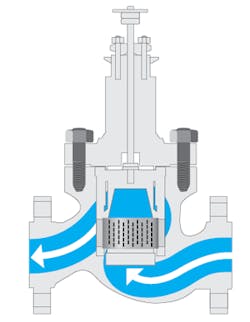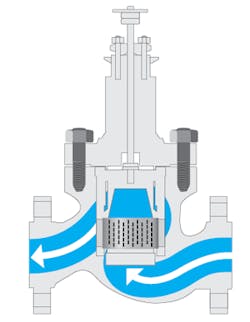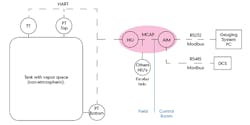Ask the experts: Temperature rise in valve? Remote tank gauging
This column is moderated by Béla Lipták, automation and safety consultant and editor of the Instrument and Automation Engineers' Handbook (IAEH). If you have an automation-related question for this column, write to [email protected].
Fábio silva
[email protected]
A: You are correct. The theory is that in a pressure let down process, the enthalpy stays constant while the air expands, if the air behaves as in ideal gas. So, just look up the enthalpy (E) of the entering air at 30 bars and 20º C, then look up what the temperature of the outlet air has to be when its pressure is 2 bars and enthalpy (E) is the same as that of the inlet air.
Figure 1: The labyrinth trim of this low-noise control valve is justified when sound reduction is worth the additional cost.
If we assume your air is an ideal gas (has no moisture, etc.), then the enthalpy is a function of temperature only, and therefore, if the enthalpy stays constant, the pressure can drop and the temperature will not rise. How close your air is to an ideal gas I don't know, but my guess is it's close, so this is theory.In practice, for the purposes of noise level calculation, you can save time by neglecting the temperature change, and just assume that the outlet temperature is the same as the inlet (20ºC). If you don't want to do that, then you can find the detailed calculations here.
In my projects, whenever the client is more concerned about aerodynamic noise than about cost, I will specify multistage or combination multipath/multistage valves (Figure 1).
Béla Lipták
[email protected]
A: The simple answer is the temperature does rise, but it is usually minor. The reason to know that change is to use the physical properties of the gas in the calculations. It's the absolute temperature that affects the flowing gas properties, and that change is small.
Valves reduce pressure by removing energy through turbulence. The heat generated is mostly carried away by the flowing gas. Some tiny fraction of the energy is converted into noise, most of which is contained in the piping.
The valve manufacturers have programs to predict noise, and these calculations are thought to be reliable. The IEC standard on aerodynamic noise prediction is IEC 60534-8-3. You may have access to that.
Cullen Langford
[email protected]
Q: Remote level monitoring? Figure 2 shows our hydrostatic tank gauging (HTG) system. Do you have a device or combination of devices that can replace the hydrostatic interface unit (HIU) and application interface module (AIM)? They are now unsupportable.
I'm open to a new communication protocol/fieldbus and possibly changing the field instruments for compatibility but my constraints are: no laying of new instrument/power/home-run cables; field is Class I, Div. 2 hazardous location; no shutdown or tank depressurization; and no new instrument impulse lines. Distance from field to control room is about 500 meters.
Note that field instruments don't have individual cables, but are daisy-chained on one twisted pair to the HIU.
The transmitters have isolation valves, and can be replaced without shutting down the process. The RTDs are insert type. There are five tanks in total with four storing products at sub-zero temperatures. The instrumentation on each tank is fully redundant, i.e. two sets of transmitters per tank on two networks.
My thought is that there should be a HART (or some other bus) device out there that can poll the transmitters in turn, perform the level computation, and communicate output to the host systems. The device can even be placed in the control room. I just haven't found any of them yet.
I have checked Honeywell's HTG system based on FDI 877, but it requires separate AC power supply, and hasn't been confirmed to be capable of powering three HART transmitters in daisy chain (versus individual wires from each instrument). I've also considered battery-powered wireless HART transmitters communicating to a gateway, but that solution has its cons.
Olusegun Komolafe
[email protected]
Figure 2: Are there HART or other bus device(s) that can replace the functions of the shaded area?
A: In your present installation, I consider the "fully redundant transmitter” approach outdated. The cost of three transmitters is usually less than the cables plus increased maintenance of the redundant. I prefer three because in a redundant system, all you know is that one is wrong, but you don't know which one. Since you have shutoff valves on the pressure transmitters, installing three of them is no problem.
Once you have a voting system, you can use wireless transmitters, because the system will automatically report which transmitter is the one that needs maintenance or battery replacement. Smart, wireless transmitters can also be useful if you want historical trend, in and out flow, vaporization loss or other, more sophisticated displays or calculations.
Béla Lipták
[email protected]
A: Moore Industries makes a HART-to-Modbus converter (HCS) that might handle this application. Here is a link.
Without chasing all of the details, I don't know for certain that it will work, but either this product (or a similar one) might be a good place to start.
Hunter Vegas
[email protected]
About the Author
Béla Lipták
Columnist and Control Consultant
Béla Lipták is an automation and safety consultant and editor of the Instrument and Automation Engineers’ Handbook (IAEH).

Leaders relevant to this article:



